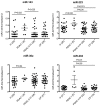Noninvasive urinary miRNA biomarkers for early detection of pancreatic adenocarcinoma
- PMID: 26807325
- PMCID: PMC4697691
Noninvasive urinary miRNA biomarkers for early detection of pancreatic adenocarcinoma
Abstract
Currently, the majority of patients diagnosed with pancreatic ductal adenocarcinoma (PDAC) present with locally invasive and/or metastatic disease, resulting in five-year survival of less than 5%. The development of an early diagnostic test is, therefore, expected to significantly impact the patient's prognosis. In this study, we successfully evaluated the feasibility of identifying diagnostic cell free microRNAs (miRNAs) for early stage PDAC, through the analysis of urine samples. Using Affymetrix microarrays, we established a global miRNA profile of 13 PDAC, six chronic pancreatitis (CP), and seven healthy (H) urine specimens. Selected differentially expressed miRNAs were subsequently investigated using an independent technique (RT-PCR) on 101 urine samples including 46 PDAC, 29 CP and 26 H. Receiver operating characteristic (ROC) and logistic regression analyses were applied to determine the discriminatory potential of the candidate miRNA biomarkers. Three miRNAs (miR-143, miR-223, and miR-30e) were significantly over-expressed in patients with Stage I cancer when compared with age-matched healthy individuals (P=0.022, 0.035 and 0.04, respectively); miR-143, miR-223 and miR-204 were also shown to be expressed at higher levels in Stage I compared to Stages II-IV PDAC (P=0.025, 0.013 and 0.008, respectively). Furthermore, miR-223 and miR-204 were able to distinguish patients with early stage cancer from patients with CP (P=0.037 and 0.036). Among the three biomarkers, miR-143 was best able to differentiate Stage I (n=6) from healthy (n=26) with area under the curve (AUC) of 0.862 (95% CI 0.695-1.000), with sensitivity (SN) of 83.3% (95% CI 50.0-100.0), and specificity (SP) of 88.5% (95% CI 73.1-100.0). The combination of miR-143 with miR-30e was significantly better at discriminating between these two groups, achieving an AUC of 0.923 (95% CI 0.793-1.000), with SN of 83.3% (95% CI 50.0-100.0) and SP of 96.2% (95% CI 88.5-100.0). In this feasibility study, we demonstrate for the first time the utility of miRNA biomarkers for non-invasive, early detection of PDAC in urine specimens.
Keywords: Pancreatic ductal adenocarcinoma; diagnostic biomarkers; miR-143; miR-204; miR-223; miR-30e; urine.
Figures



References
-
- Shimizu Y, Yasui K, Matsueda K, Yanagisawa A, Yamao K. Small carcinoma of the pancreas is curable: new computed tomography finding, pathological study and postoperative results from a single institute. J Gastroenterol Hepatol. 2005;20:1591–1594. - PubMed
-
- Bartel DP. MicroRNAs: genomics, biogenesis, mechanism, and function. Cell. 2004;116:281–297. - PubMed
-
- Lu J, Getz G, Miska EA, Alvarez-Saavedra E, Lamb J, Peck D, Sweet-Cordero A, Ebert BL, Mak RH, Ferrando AA, Downing JR, Jacks T, Horvitz HR, Golub TR. MicroRNA expression profiles classify human cancers. Nature. 2005;435:834–838. - PubMed
-
- Roldo C, Missiaglia E, Hagan JP, Falconi M, Capelli P, Bersani S, Calin GA, Volinia S, Liu CG, Scarpa A, Croce CM. MicroRNA expression abnormalities in pancreatic endocrine and acinar tumors are associated with distinctive pathologic features and clinical behavior. J. Clin. Oncol. 2006;24:4677–4684. - PubMed
-
- Bloomston M, Frankel WL, Petrocca F, Volinia S, Alder H, Hagan JP, Liu CG, Bhatt D, Taccioli C, Croce CM. MicroRNA expression patterns to differentiate pancreatic adenocarcinoma from normal pancreas and chronic pancreatitis. JAMA. 2007;297:1901–1908. - PubMed
LinkOut - more resources
Full Text Sources
Other Literature Sources
Molecular Biology Databases
Miscellaneous
